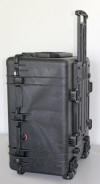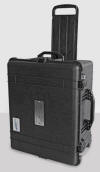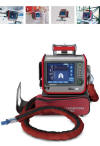The HAMILTON-T1 combines for the first time the functionality of a fully featured intensive care unit ventilator with the compactness and ruggedness required for transport. This is why the HAMILTON-T1 enables you to provide optimal ventilation therapy to all patient groups during transport, from the neonate to the adult.
The integrated high-performance turbine enables the HAMILTON-T1 to be completely independent from compressed air. This reduces weight and saves space, and allows even noninvasively ventilated patients to be transported successfully across greater distances.
The HAMILTON-T1 includes
Hamilton Medical's standardized Ventilation Cockpit user
interface and the unique intelligent ventilation mode, Adaptive
Support Ventilation® (ASV®).
The HAMILTON-T1 for Armed Forces faithfully
accompanies your patients to any destination on the Ground,
at Sea, and in the Air. After successfully passing the
tests for military compliance according to highest demands under
toughest conditions, the HAMILTON-T1 was
registered for a NATO stock number (NSN 6515-01-648-5814), and
is now officially available in the US military ECAT catalog.

Adult, Pediatric, and Neonatal
Ventilation

The HAMILTON-T1 mechanical ventilator provides
effective, safe, and lung-protective ventilation for adult,
pediatric, and neonatal patients. For neonatal patients, a
specifically developed neonatal proximal flow sensor is used.
The tidal volume range goes down to 2 ml.
Mobility for Primary, Secondary, and
Intra-Hospital Transport
The integrated high-performance turbine enables the HAMILTON-T1 mechanical ventilator Transport Ventilator to be completely independent from compressed air. This reduces weight and saves space, as there is no need for gas cylinders or a compressor. This allows even noninvasively ventilated patients to be transported successfully across greater distances.
A battery operating time of more than 9 hours is provided by one integrated and one hot-swappable battery. The battery operating time can be prolonged indefinitely with additional hot-swappable batteries.
The lightweight compact design of the HAMILTON-T1 Transport Ventilator makes handling of the ventilator much easier. The water-resistant housing offers impact protection and a shock-resistant, anti-reflective display. The HAMILTON-T1 transport ventilator is a rugged and reliable companion.
Approved for all types of Transport
The HAMILTON-T1
transport ventilator meets the transport standards of ISO
10651-3 for Emergency and Transport Ventilators.
It reliably accompanies your patients to any destination either
within or outside of the hospital, on
the ground, at sea, and in the air.

Hot-Swappable Battery Backup
A battery operating time of more than
9 hours is provided by one integrated and one hot-swappable
battery. The battery operating time can be prolonged
indefinitely with the use of additional hot-swappable batteries.

Adaptive Support Ventilation (ASV) for
Lung-Protective Ventilation

All Hamilton Medical ventilators feature the intelligent
ventilation mode, Adaptive Support Ventilation® (ASV®). ASV
continuously adjusts respiratory rate, tidal volume, and
inspiratory time depending on the patient’s lung mechanics and
effort. ASV adapts ventilation breath-by-breath, 24 hours a day,
from intubation to extubation.
A lung-protective strategy ensures ASV’s safety. ASV attempts to guide the patient using a favorable breathing pattern and avoids potentially detrimental patterns. ASV has been a well established mode in critical care since 1998 and has become a standard mode in many units around the world.
Clinical studies show that ASV:
- Supports the earliest possible spontaneous breathing by the patient
- Shortens the ventilation time in various patient populations
- Reduces the number of interventions
by the clinical staff
- Intelligent ventilation mode for passive and spontaneously breathing adult and pediatric patients
- Automatically adjusts ventilation to lung mechanics and applies lung-protective strategies
- Shortens ventilation time
https://www.hamilton-medical.com/en_US/Solutions/Adaptive-Support-Ventilation-ASV.html
https://youtu.be/d35qx0A3PAg
Ventilation Adapted to the Patient
All Hamilton Medical ventilators feature the intelligent ventilation mode Adaptive Support Ventilation (ASV). ASV adjusts respiratory rate, tidal volume, and inspiratory time continuously depending on the patient’s lung mechanics and effort. ASV adapts ventilation breath-by-breath, 24 hours a day, and from intubation to extubation.
ASV automatically employs lung-protective strategies to minimize complications from AutoPEEP and volutrauma/barotrauma. It also prevents apnea, tachypnea, dead space ventilation, and excessively large breaths. Within the rules of this lung-protective strategy, ASV encourages the patient to breathe spontaneously.
ASV is a well established mode in critical care since 1998 and has become a standard mode in many units around the world. ASV has been successfully used in a variety of patient groups — including post-operative, COPD, and ARDS patients (Celli 2014, Agarwal 2013, Kirakli 2011, Gruber 2008, Sulzer 2001).
Since its introduction in 1998, ASV has received a lot of interest from the scientific community and has been the topic of well over 30 studies.
Studies show that:
- In passive patients, ASV selects different tidal volume / respiratory rate combinations for normal lung, COPD, and ARDS patients (Arnal 2008).
- In active patients, ASV decreases work of breathing and improves patient-ventilator synchrony (Wu 2010, Tassaux 2010).
- In the ICU, ASV decreases the weaning duration in medical patients (Chen 2011) and COPD patients (Kirakli 2011).
- In post-cardiac surgery, ASV allows
earlier extubation than conventional modes
(Gruber 2008, Sulzer 2001) with fewer manual
adjustments (Petter 2003) and fewer ABG
analyses performed (Sulzer 2001).
ASV maintains an operator set minute volume and automatically determines an optimal tidal volume / respiratory rate combination based on the minimal work of breathing principle described by Otis (Otis 1954). ASV takes into account the patient’s respiratory mechanics, which are measured breath-by-breath by the proximal flow sensor. ASV ensures optimal ventilation for each patient during passive ventilation, spontaneous breathing, and weaning.
ASV in passive patients
In passive patients, ASV is a volume-targeted pressure controlled mode with automatic adjustment of inspiratory pressure, respiratory rate, and inspiratory/expiratory time ratio. Maximum tidal volume is controlled by setting a maximum inspiratory pressure. Expiratory time is determined according to the expiratory time constant in order to prevent dynamic hyperinflation.
ASV in active patients
In spontaneously breathing patients, ASV is a volume-targeted pressure support mode with automatic adjustment of pressure support according to the spontaneous respiratory rate. The automatic decrease of pressure support when the patient recovers their inspiratory strength is very useful for weaning. ASV can also be used to perform a weaning trial before extubation.











